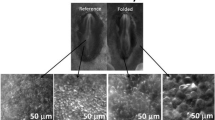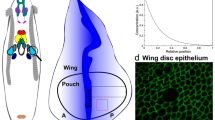Abstract
We present a model for the formation of parallel rows of scale cells in the developing adult wing of moths and butterflies. Precursors of scale cells differentiate throughout each epithelial monolayer and migrate into rows that are roughly parallel to the body axis. Grafting experiments have revealed what appears to be a gradient of adhesivity along the wing. What is more, cell adhesivity character is maintained after grafting. Thus we suggest that it is a cell’s location prior to migration that determines its interactions during migration. We use nonlinear bifurcation analysis to show that differential origin-dependent cell adhesion can result in the stabilization of rows over spots.
Similar content being viewed by others
References
Bard, J. B. L. (1981). Atitle model for generating aspects of zebra and other mammalian coat patterns. J. Theor. Biol 93, 363–385.
Campos-Ortega, J. A. (1988). Cellular interaction during early neurogenesis of Drosophila melanogaster. Trends Neurosci 11, 400–405.
Campuzano, S. and J. Modolell (1992). Patterning of the Drosophila nervous system: the achaete-scute gene complex. Trends Genetics 8, 202–208.
Collier, J. R., N. A. M. Monk, P. K. Maini and J. H. Lewis (1996). Pattern formation by lateral inhibition with feedback: a mathematical model of Delta-Notch intercellular signalling. J. Theor. Biol. 183, 429–446.
Doe, C. Q. and C. S. Goodman (1985). Early events in insect neurogenesis, II The role of cell interactions and cell lineage in the determination of neuronal precursor cells. Dev. Biol. 111, 206–219.
Ermentrout, B. (1991). Stripes or spots? Nonlinear effects in bifurcation of reaction-diffusion equations on the square. Proc. R. Soc. Lond. Ser. A 434, 413–417.
Fife, P. (1979). Mathematical Aspects of Reacting and Diffusing Systems Lecture Notes in Biomathematics, 28, Springer-Verlag.
Heitzler, P. and P. Simpson (1991). The choice of cell fate in the epidermis of Drosophila. Cell 64, 1083–1093.
Held, L. I. (1991). Bristle patterning in Drosophila. Bioessays 13, 633–640.
Held, L. I. (1993). Models for Embryonic Periodicity, Basel: Karger.
Honda, H., M. Tanemura and A. Yoshida (1990). Estimation of neuroblast numbers in insect neurogenesis using the lateral inhibition hypothesis of cell differentiation. Development 110, 1349–1352.
Jordan, D. W. and P. Smith (1987). Nonlinear Ordinary Differential Equations, Oxford: Oxford University Press.
Kadmon, G., A. Kowitz, P. Altevogt and M. Schachner (1990). The neural cell adhesion molecule N-CAM enhances L1-dependent cell—cell interactions. J. Cell Biol. 110, 193–208.
Locke, M. and P. Huie (1981). Epidermal feet in insect morphogenesis. Nature 293, 733–735.
Lyons, M. J. and L. G. Harrison (1991). Stripes and spots and isolated structures: the pattern-forming abilities of diverse non-linearities in reaction-diffusion mechanisms, NWPMB workshop, Vancouver B.C.
Lyons, M. J. and L. G. Harrison (1992). Stripe selection: an intrinsic property of some pattern-forming models with nonlinear dynamics. Dev. Dyn. 195, 201–215.
Kondo, S. and R. Asai (1995). A reaction-diffusion wave on the skin of the marine angelfish Pomacanthus. Nature 376, 765–768.
Kopell, N. and L. N. Howard (1973). Horizontal bands in the Belousov reaction. Science 180, 1171–1173.
Maini, P. K. and J. D. Murray (1988). A nonlinear analysis of a mechanical model for biological patternformation. SIAM. J. Appl. Math. 48, 1064–1072.
Mauro, V. P., L. A. Krushel, B. A. Cunningham and G. M. Edelman (1992). Homophilic and heterophilic binding activities of Nr-CAM, a nervous system cell adhesion molecule. J. Cell Biol. 119, 191–202.
Murray, J. D. (1980). Lecture Notes in Biomathematics, Berlin, Heidelberg, New York: Springer, pp. 360–399.
Murray, J. D. (1981). A pre-pattern formation mechanism for animal coat markings. J. Theor. Biol. 88, 161–199.
Murray, J. D. (1993). Mathematical Biology, Springer-Verlag.
Murray, J. D., D. C. Deeming and M. W. J. Ferguson (1990). Size dependent pigmentation pattern formation in embryos of Alligator mississippiensis: time of initiation of pattern generation mechanism. Proc. R. Soc. Lond. Ser. B 239, 279–293.
Murray, J. D and M. R. Myerscough (1991). Pigmentation pattern formation on snakes. J. Theor. Biol. 149, 339–360.
Nagorcka, B. N. and J. R. Mooney (1992). From stripes to spots: prepatterns which can be produced in the skin by a reaction-diffusion system. IMA J. Math. Appl. Biol. Med. 9, 249–267.
Nardi, J. B. (1988). Establishment of a two-dimensional neural network in an insect wing. Current Issues in Neural Regeneration Research, Liss A.R., 127–136.
Nardi, J. B. (1992). Dynamic expression of a cell surface protein during rearrangement of epithelial cells in the Manduca wing monolayer. Dev. Biol. 152, 161–171.
Nardi, J. B. (1994). Rearrangement of epithelial cell types in an insect wing monolayer is accompanied by differential expression of a cell surface protein. Dev. Dyn. 199, 315–325.
Nardi, J. B. and S. M. Magee-Adams (1986). Formation of scale spacing patterns in a moth wing. I. Epithelial feet may mediate cell rearrangement. Dev. Biol. 116, 278–290.
Nijhout, H. F. (1980). Ontogeny of the color pattern on the wing of Precis coenia (Lepidoptera: Nymphalidae). Dev. Biol. 80, 275–288.
Oster, G. F. and J. D. Murray (1989). Pattern formation models and development. Zool. 251, 186–202.
Sekimura, T. and A. Yoshida (1990). A model for cellular pattern formation of scales in a butterfly wing. Forma 5, 73–82.
Simpson, P. (1990). Lateral inhibition and the development of the sensory bristles of the adult peripheral nervous system of Drosophila. Development 109, 509–519.
Turing, A. M. (1952). The chemical basis of morphogenesis. Phil. Trans. R. Soc. Lond. Ser. B 237, 37–72.
Varea, C., J. L. Aragón and R. A. Barrio (1997). Confined Turing patterns in growing systems. Phys. Rev. E56, 1250–1253.
Walgraef, D., G. G. Dewel and P. Borckmans (1982). Nonequilibrium phase transitions and chemical instability. Adv. Chem. Phys. XLIX, 311–355.
Yoshida, A. and K. Aoki (1989). Scale arrangement pattern in a lepidopteran wing. I. Periodic cellular pattern in pupal wing of Pieris rapae. Dev. Growth Differ. 31, 601–609.
Yoshida, A. (1993). The spatial pattern of the cell distribution and the cell number ratio determined by competition and lateral inhibition in the butterfly wing. Forma 8, 203–210.
Zhu, M. and J. D. Murray (1995a). Parameter domains for generating spatial pattern: a comparison of reaction-diffusion and cell-chemotaxis models. Int. J. Bifurcation Chaos 5, 1503–1524.
Zhu, M. and J. D. Murray (1995b). Parameter domains for spots and stripes in mechanical models for biological pattern formation. J. Nonlinear Sci. 5, 317–336.
Author information
Authors and Affiliations
Rights and permissions
About this article
Cite this article
Sekimura, T., Zhu, M., Cook, J. et al. Pattern formation of scale cells in lepidoptera by differential origin-dependent cell adhesion. Bull. Math. Biol. 61, 807–828 (1999). https://doi.org/10.1006/bulm.1998.0062
Received:
Accepted:
Issue Date:
DOI: https://doi.org/10.1006/bulm.1998.0062




